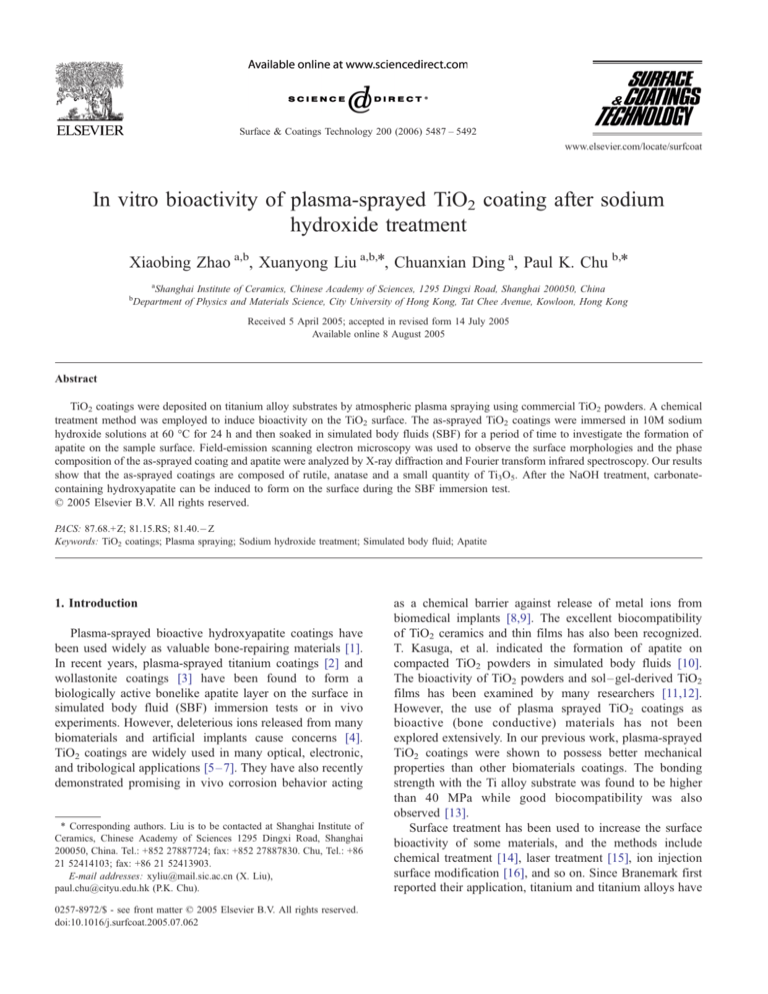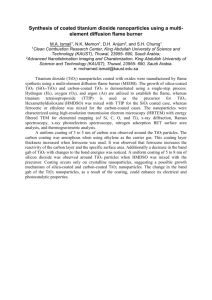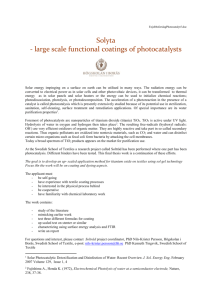
Surface & Coatings Technology 200 (2006) 5487 – 5492
www.elsevier.com/locate/surfcoat
In vitro bioactivity of plasma-sprayed TiO2 coating after sodium
hydroxide treatment
Xiaobing Zhao a,b, Xuanyong Liu a,b,*, Chuanxian Ding a, Paul K. Chu b,*
b
a
Shanghai Institute of Ceramics, Chinese Academy of Sciences, 1295 Dingxi Road, Shanghai 200050, China
Department of Physics and Materials Science, City University of Hong Kong, Tat Chee Avenue, Kowloon, Hong Kong
Received 5 April 2005; accepted in revised form 14 July 2005
Available online 8 August 2005
Abstract
TiO2 coatings were deposited on titanium alloy substrates by atmospheric plasma spraying using commercial TiO2 powders. A chemical
treatment method was employed to induce bioactivity on the TiO2 surface. The as-sprayed TiO2 coatings were immersed in 10M sodium
hydroxide solutions at 60 -C for 24 h and then soaked in simulated body fluids (SBF) for a period of time to investigate the formation of
apatite on the sample surface. Field-emission scanning electron microscopy was used to observe the surface morphologies and the phase
composition of the as-sprayed coating and apatite were analyzed by X-ray diffraction and Fourier transform infrared spectroscopy. Our results
show that the as-sprayed coatings are composed of rutile, anatase and a small quantity of Ti3O5. After the NaOH treatment, carbonatecontaining hydroxyapatite can be induced to form on the surface during the SBF immersion test.
D 2005 Elsevier B.V. All rights reserved.
PACS: 87.68.+Z; 81.15.RS; 81.40. Z
Keywords: TiO2 coatings; Plasma spraying; Sodium hydroxide treatment; Simulated body fluid; Apatite
1. Introduction
Plasma-sprayed bioactive hydroxyapatite coatings have
been used widely as valuable bone-repairing materials [1].
In recent years, plasma-sprayed titanium coatings [2] and
wollastonite coatings [3] have been found to form a
biologically active bonelike apatite layer on the surface in
simulated body fluid (SBF) immersion tests or in vivo
experiments. However, deleterious ions released from many
biomaterials and artificial implants cause concerns [4].
TiO2 coatings are widely used in many optical, electronic,
and tribological applications [5– 7]. They have also recently
demonstrated promising in vivo corrosion behavior acting
* Corresponding authors. Liu is to be contacted at Shanghai Institute of
Ceramics, Chinese Academy of Sciences 1295 Dingxi Road, Shanghai
200050, China. Tel.: +852 27887724; fax: +852 27887830. Chu, Tel.: +86
21 52414103; fax: +86 21 52413903.
E-mail addresses: xyliu@mail.sic.ac.cn (X. Liu),
paul.chu@cityu.edu.hk (P.K. Chu).
0257-8972/$ - see front matter D 2005 Elsevier B.V. All rights reserved.
doi:10.1016/j.surfcoat.2005.07.062
as a chemical barrier against release of metal ions from
biomedical implants [8,9]. The excellent biocompatibility
of TiO2 ceramics and thin films has also been recognized.
T. Kasuga, et al. indicated the formation of apatite on
compacted TiO2 powders in simulated body fluids [10].
The bioactivity of TiO2 powders and sol – gel-derived TiO2
films has been examined by many researchers [11,12].
However, the use of plasma sprayed TiO2 coatings as
bioactive (bone conductive) materials has not been
explored extensively. In our previous work, plasma-sprayed
TiO2 coatings were shown to possess better mechanical
properties than other biomaterials coatings. The bonding
strength with the Ti alloy substrate was found to be higher
than 40 MPa while good biocompatibility was also
observed [13].
Surface treatment has been used to increase the surface
bioactivity of some materials, and the methods include
chemical treatment [14], laser treatment [15], ion injection
surface modification [16], and so on. Since Branemark first
reported their application, titanium and titanium alloys have
5488
X. Zhao et al. / Surface & Coatings Technology 200 (2006) 5487 – 5492
been widely used as implant materials, and their bioactivities are believed to be linked to TiO2 [17]. Kim et al. first
introduced alkali and heat treatments to improve the
bioactivity [18]. Further research indicated that apatite was
formed on the surface of pure titanium, including NaOHtreated and NaOH-heat-treated substrates [19]. In our
previous works, bone-like apatite could be induced on the
surface of plasma-sprayed titanium coatings treated with
NaOH in simulated body fluid immersion tests [2]. After the
materials were implanted into a dog femur, new bone was
found to form on the surface of the NaOH-treated implant
surface [20]. However, the titanium oxide layer formed on
the surface of the titanium or titanium coatings is so thin that
ion release from the materials is a concern thereby shortening the lifetime of the implant. The purpose of this work
is to obtain a relatively thick TiO2 coating by plasma
spraying followed by the inducing of surface bioactivity
using the NaOH treatment. Introduction of surface bioactivity (bone conductivity) to plasma-sprayed TiO2 coatings which are generally recognized to have excellent
biocompatibility and corrosion resistance as well as high
bonding to titanium alloys makes them more superior than
many current biomedical coatings.
2. Experimental details
Commercial titanium alloy (Ti6Al4V) blocks of
10 10 2 mm were employed as substrates. Prior to
plasma spraying, all the substrates were sandblasted with
brown corundum. A commercial TiO2 powder (Wuhan,
China) agglomerated by the spray drying method was used
as the feedstock in the plasma spray experiments. The
coatings were prepared by an atmospheric plasma spraying
system, including a Sulzer Metco F4-MB plasma gun
mounted on an ABB S3 robot. The main spraying
parameters are listed in Table 1.
The as-sprayed coatings were ultrasonically cleaned in
acetone and deionized water, and then were immersed in
10M NaOH aqueous solutions at 60 -C for 24 h. After
washing in deionized water, the as-sprayed and NaOHtreated coatings were soaked in SBF to investigate their
bioactivities. The ion concentrations of the SBF are nearly
equal to those of human blood plasma, as shown in
reference [13]. The SBF was buffered at PH 7.4 at 37 -C
with trimethanol aminomethane and hydrochloric acid.
Fig. 1. XRD pattern of TiO2 powders.
After soaking in SBF for two and four weeks, the samples
were taken out, rinsed with deionized water, dried, and then
inspected or tested using various methods.
The phase characterization of the coatings before and
after SBF tests were conducted by X-ray diffraction (XRD)
employing a JAPAN-RICOH diffractometer equipped with
a Ni-filtered Cu Ka radiation (k = 1.5418 Å) source. In the
thin film X-ray diffraction (TFXRD) experiments, the
glancing angle of the incident beam was fixed at 2-. A few
micrograms of the Ca-P layer formed on the coating in
SBF were scraped off. This was mixed with KBr and
pressed for structural analysis using Fourier transfer
infrared (FTIR) spectroscopy using a Bio Rad FTS-185.
The surface morphologies, cross-sectional microstructures,
and composition of the as-sprayed and NaOH-treated
coatings were examined by field-emission scanning electron microscopy (FE-SEM) and energy-dispersive X-ray
spectrometry (EDS) using a JEOL JSM-6700F SEM and
electron probe X-ray microanalysis (EPMA-8705QH2,
Shimadzu, Japan). The surface compositions of the TiO2
Higher magnification
Table 1
Plasma spraying parameters
Ar gas flow (slpm*)
H2 gas flow (slpm)
Arc current (A)
Arc voltage (V)
Spraying distance (mm)
*slpm: standard liter per minute.
40
12
600
70
100
Fig. 2. SEM image of spray-dried TiO2 powders.
X. Zhao et al. / Surface & Coatings Technology 200 (2006) 5487 – 5492
5489
3. Results and discussion
Fig. 3. XRD pattern of as-sprayed TiO2 coating.
coatings before and after NaOH treatment were determined
by Auger electron emission spectroscopy (AES) using a
FISONS, MICROLAB-310F. The surfaces of TiO2 coatings before and after NaOH treatment were carefully
cleaned by deionized water and dried at 100oC before the
AES analysis.
The XRD pattern of the TiO2 powders shown in Fig. 1
reveals that the rutile content in the original powder is
about 95%. Fig. 2 shows the SEM image of the spraydried powders. The shape of the spray-dried powders was
similarly spherical having sizes of 30 to 70 Am. The
higher magnification analysis of the spray-dried particles
indicates that the size of the original powder is about
0.3 Am.
Fig. 3 depicts the X-ray diffraction pattern acquired from
the plasma-sprayed TiO2 coating. It can be seen that the assprayed coating is primarily composed of the rutile phase
and a small amount of anatase and TiO2 x (most of them
is Ti3O5). The deoxidization of TiO2 is due to the cooling
rate of the molten or partially molten droplets being in
excess of 106 K/s and low oxygen partial pressure during
plasma spraying [21]. It is well known that the rutile phase
is a stable phase from the viewpoint of thermodynamics
whereas the anatase phase is a metastable phase and will be
transformed to rutile at about 1100K [22]. During plasma
(a)
(b)
Ti O 2 coating
Ti alloy substrate
Fig. 4. Morphologies of as-sprayed TiO2 coating: (a) surface, (b) cross
section.
Fig. 5. AES depth profiles of TiO2 coating: (a) as-sprayed, (b) treated by
NaOH solution.
5490
X. Zhao et al. / Surface & Coatings Technology 200 (2006) 5487 – 5492
researchers have also reported that the TiO2 coatings
produced by plasma spraying consist mainly of the rutile
phase with a low fraction of anatase phase, despite the
crystalline structure of the initial powders [22,23].
The surface and cross sectional morphologies of the assprayed coating are displayed in Fig. 4. The as-sprayed
coating exhibits a rough surface with some pores and the
porosity is about 6% by Archimedes method. Excellent
adhesion is observed between the TiO2 coatings and Ti-6Al4V substrate (Fig. 4b) and the bonding strength is about 38
MPa based on a tensile adhesion test (ASTM C 633-79).
The change in the surface chemistry after NaOH treatment is evaluated by AES depth profiling analysis, and the
AES depth profiles of the TiO2 coatings before and after
NaOH treatment are shown in Fig. 5. The surface of the assprayed coating is composed of Ti and O (Fig. 5a). After
NaOH treatment, Na is also found (Fig. 5b). The results
indicate the formation of a sodium titanate layer on the TiO2
coating after NaOH treatment.
Fig. 6 shows the surface views of the as-sprayed and
NaOH-treated TiO2 coatings after soaking in SBF for two
and four weeks. In Fig. 6b, it can be seen that the surface of
the NaOH-treated TiO2 coating after SBF immersion for two
weeks is completely covered by porous ball-like particles.
The surface morphology is very different from that of the assprayed coating. After a longer immersion period, microcracks resembling those on a tortoise shell appear on the
newly formed layer (Fig. 6c). After four weeks of SBF
immersion, the entire surface of the NaOH-treated TiO2
coating is covered by white crystals visible to the naked
eyes. The EDS analysis corresponding to the features shown
in Fig. 6c indicates that the newly formed layer on the
surface of NaOH-treated titania coating is composed of
calcium and phosphate. The EDS quantitative analysis gives
a Ca to P ratio of around 1.53 that is nearly equal to the
composition of hydroxyapatite (Ca / P= 1.67). In contrast,
the surface of the as-sprayed coating without NaOH
treatment retains the original morphology after immersion
in SBF for four weeks (Fig. 6a).
Fig. 6. Surface morphologies of TiO2 coatings after SBF immersion: (a) assprayed after immersion for four weeks, (b) treated by NaOH and
immersion for two weeks and (c) treated by NaOH and immersion for
four weeks.
spraying, the powders are heated and accelerated and then
projected onto the substrates, followed by flattening, rapid
cooling and solidification. Hence, most powders are melted
in the plasma flame. The metastable anatase phase can be
partly retained due to the rapid cooling process. Some
Fig. 7. TFXRD pattern of NaOH-treated TiO2 coating soaked in SBF for
four weeks.
X. Zhao et al. / Surface & Coatings Technology 200 (2006) 5487 – 5492
5491
calcium phosphate phase that accumulates on the surface of
the NaOH-treated TiO2 coatings is initially amorphous (aCaP). It later crystallizes to a carbonate-containing hydroxyapatite (bone-like apatite) structure by incorporating
carbonate anions from the solution with the a-CaP phase
[29].
4. Conclusion
Fig. 8. FTIR spectrum of NaOH-treated TiO2 coatings soaked in SBF for
four weeks.
The thin film X-ray diffraction pattern acquired from
the Ca-P layer on the NaOH-treated TiO2 coating soaked
in SBF for 4 weeks is exhibited in Fig. 7. The peaks
corresponding to the crystalline apatite phase are observed
in the TFXRD pattern. The peaks of the apatite crystallite
were very broad, indicating that the apatite layer consists of
superfine crystalline and/or defective structure grains [24].
Fig. 8 shows the FTIR spectrum of the NaOH-treated TiO2
coating soaked in SBF for four weeks. The bands at 560 –
600 cm 1 and 1030 –1090 cm 1 represent the characteristic
peaks of the PO43 group [25]. The band at around 1650
cm 1 can be assigned to absorbed H2O characteristic of
precipitates in aqueous solutions. The OH absorption
around 3500 cm 1 is observed in the FTIR spectrum. The
bands between 1400 and 1550 cm 1 indicate the presence
of the CO32 group [26]. The results obtained from TFXRD
and FTIR suggest that the newly formed layer on the NaOHtreated TiO2 coating is composed of carbonate-containing
hydroxyapatite (bone-like apatite).
The mechanism of apatite formation on the surface of
NaOH-treated coating in the SBF is similar to that on
NaOH-treated titanium. TiO2 reacts with the NaOH solution
to form sodium titanate. The sodium titanate releases Na+
ions via exchange with the H3O+ ions in the SBF to form
Ti– OH groups on its surface. Li et al. suggested that OH
groups on ceramic surfaces were effective in inducing the
formation of an apatite layer [27]. The Ti –OH groups can
form negative charges in the SBF solution and immediately
combine with the positively charged Ca2+ ions in the SBF to
form amorphous calcium titanate. This calcium titanate
layer combines with phosphate ions in the SBF to form
amorphous calcium phosphate and then the calcium
phosphate transforms into apatite [28]. Once the apatite
nuclei are formed, they spontaneously grow by consuming
calcium and phosphate ions from the SBF solution. The
TiO2 coatings were deposited on Ti-6Al-4V substrates
using atmospheric plasma spraying. The as-sprayed coating
is primarily composed of the rutile phase and a small
amount of anatase and TiO2 x (most of them is Ti3O5). The
porosity of the as-sprayed coating is about 6% and the
bonding strength between coating and titanium alloy
substrate is about 38 MPa. After NaOH treatment, carbonate-containing hydroxyapatite (bone-like apatite) can be
formed on the surface in SBF immersion tests. In contrast,
no hydroxyapatite can be observed on the surface of the assprayed coating without NaOH treatment under the same
SBF immersion conditions. Our results show that bioactivity
can be induced on plasma-sprayed TiO2 coatings by the
NaOH solution treatment. The formation mechanism
includes the formation of sodium titanate on the surface of
the NaOH-treated TiO2 coatings, followed by the release of
Na+from the sodium titanate via exchange with the H3O+
ions in the SBF to form the Ti– OH groups thereby inducing
apatite precipitate on the surface of the treated TiO2 coating.
Acknowledgments
This work was jointly supported by Shanghai Science
and Technology R and D Fund under grant 02QE14052
and 03JC14074, Innovation Fund of SICCAS under
grant SCX200410, Hong Kong Research Grants Council
(RGC) Competitive Earmarked Research Grants (CERG)
CityU 1137/03E and CityU1120/04E, and Hong Kong
Research Grants Council (RGC) Central Allocation Grant
CityU 1/04C.
References
[1] D.M. Liu, H.M. Chou, J.D. Wu, J. Mater. Sci., Mater. Med. 5 (1994)
147.
[2] J. Shi, C. Ding, Y. Wu, Surf. Coat. Technol. 137 (2001) 97.
[3] X. Liu, C. Ding, Surf. Coat. Technol. 153 (2002) 173.
[4] B.S. Ng, I. Annergren, A.M. Soutar, K.A. Khor, A.E.W. Jarfor,
Biomaterials 26 (2005) 1087.
[5] K. Fukushima, I. Yamada, J. Appl. Phys. 65 (1989) 619.
[6] M.H. Shuail, G.M. Rao, S. Mohan, J. Appl. Phys. 71 (1992) 1421.
[7] M.I. Mendelson, Wear 50 (1978) 71.
[8] B. Thierry, M. Tabrizian, C. Trepanier, O. Savadogo, L.H. Yahia,
J. Biomed. Mater. Res. 51 (2002) 685.
[9] D.J. Wever, A.G. Veldhuizen, J.D. Vries, H.J. Busscher, D.R.A. Uges,
J.R.V. Horn, Biomaterials 19 (1998) 761.
5492
X. Zhao et al. / Surface & Coatings Technology 200 (2006) 5487 – 5492
[10] T. Kasuga, H. Kondo, M. Nogami, J. Cryst. Growth 235 (2002) 235.
[11] M. Keshmiri, T. Troczynski, J. Non-Cryst. Solids 324 (2003) 289.
[12] T. Peltola, M. Jokinen, H. Rahiala, M. Ptsi, J. Heikkilä, I.
Kangasniemi, A. Yli-Urpo, J. Biomed. Mater. Res. 51 (2000) 200.
[13] X. Liu, C. Ding, Biomaterials 23 (2002) 4065.
[14] H.M. Kim, F. Miyaji, T. Kokubo, S. Nishiguchi, T. Nakamura,
J. Biomed. Mater. Res. 45 (1999) 100.
[15] N. Moritz, M. Jokinen, T. Peltola, S. Areva, A. Yli-Urpo, J. Biomed.
Mater. Res. 65A (2003) 9.
[16] X. Liu, R.K.Y. Fu, R.W.Y. Poon, P. Chen, P.K. Chu, C. Ding,
Biomaterials 25 (2004) 5575.
[17] M. Keshniri, T. Troczynski, J. Non-Cryst. Solids 324 (2003) 289.
[18] H.M. Kim, F. Miyaji, T. Kokubo, T. Nakamura, J. Biomed. Mater. Res.
32 (1996) 409.
[19] H.M. Kim, F. Miyaji, T. Kokubo, S. Nishiguchi, T. Nakamura,
J. Biomed. Mater. Res. 45 (1999) 100.
[20] W. Xue, X. Liu, X. Zheng, C. Ding, Biomaterials 26 (2005) 3029.
[21] X.Y. Wang, Z. Liu, H. Liao, D. Klein, C. Coddet, Thin Solid Films
473 (2005) 177.
[22] S. Matsusaka, A. Ohmori, Y. Toki, Thermal Spray 2001: New
Surfaces for a New Millennium, ASM International, Material Park,
Ohio, USA, 2001, p. 87.
[23] G.J. Yang, C.J. Li, F. Han, A. Ohmori, Thin Solid Films 466 (2004)
81.
[24] T. Kokubo, A/W glass-ceramics: processing and properties, in: L.L.
Hench, J. Wilson (Eds.), An Introduction to Bioceramics, World
Scientific, USA, 1993, p. 75.
[25] X. Nie, A. Leyland, A. Matthews, J.C. Jiang, E.I. Meletis, J. Biomed.
Mater. Res. 57 (2001) 612.
[26] J. Weng, Q. Liu, J.G.C. Wolke, X. Zhang, K. de Groot, Biomaterials
18 (1997) 1027.
[27] P. Li, C. Ohtsuki, T. Kokubo, K. Nakanishi, N. Soga, K. de Groot,
J. Biomed. Mater. Res. 28 (1994) 7.
[28] T. Kokubo, H.M. Kim, M. Kawashita, Biomaterials 24 (2003)
2161.
[29] L. Hench, O. Anderson, Bioactive Glass, in: L. Hench, J. Wilson
(Eds.), An Introduction to Bioceramics, World Scientific, Singapore,
1993, p. 41.






